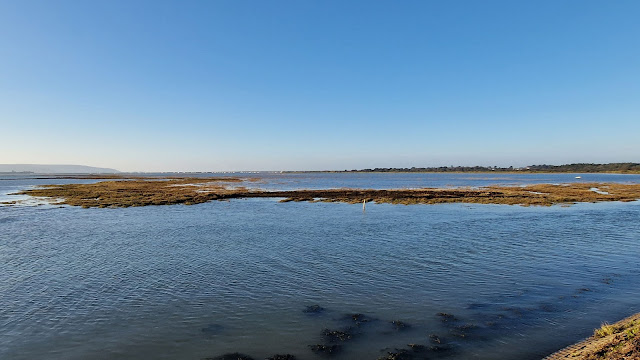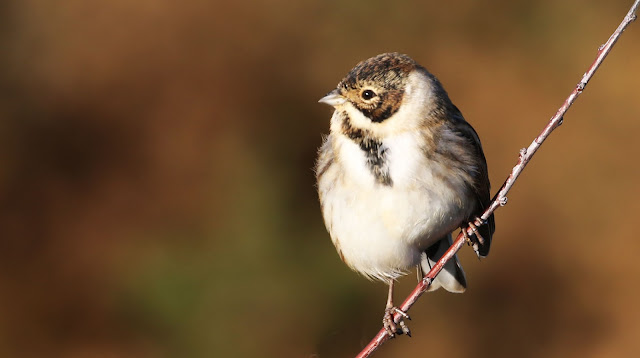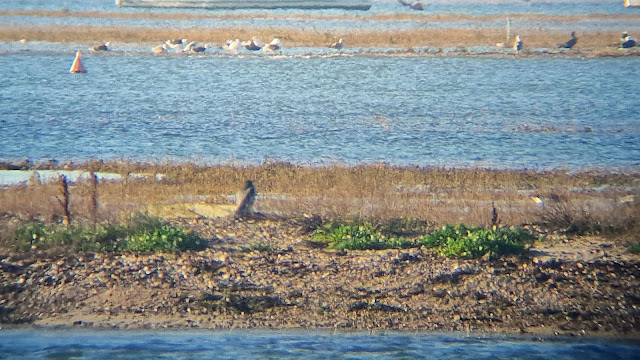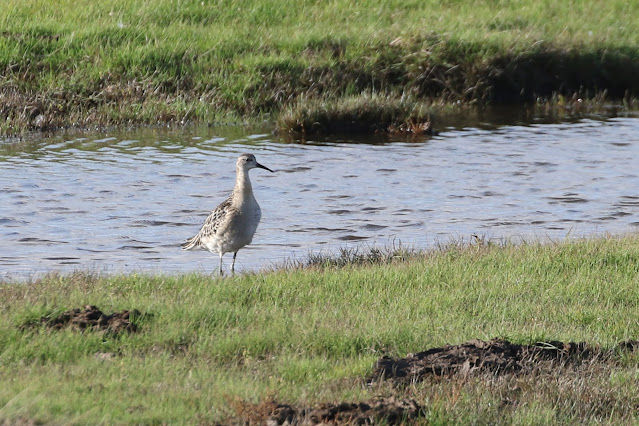An appalling forecast for the weekend and a glorious day predicted for the Friday had me decide to take the day off and experience "in the week birding". I didn't set off too early and I immediately experienced a different amount of traffic to that of the weekend, but eventually arrived at the sea wall car park on Lower Pennington Lane, where, while not full, there were plenty of cars.
The sun was just up, it felt cooler than of late, but nothing like it should be feeling, it also looked like it was going to be another mild day. I can't recall any previous November when I have not worn to warm winter coat before and I can't see me doing so anytime soon either.
I set off across the Old Tip heading for Fishtail, there was now plenty of water on the marshes and it was looking like it should do. On the marsh was a group of Greylag Geese, I recall when the Bean Geese were here a few years ago that Greylag aren't that common here, so this little of group of twenty geese was quite significant.
As I reached the sea wall I was amazed at how high the tide was, most of the marsh was covered in water here looking towards Keyhaven across Butts Bay. As you can see it was a beautiful morning
With the tide so high there were several flocks of Dunlin wheeling around the open water, while a large group were also roosting on the marsh at the back of Fishtail. Two Ruff could be seen feeding along the edge of the long spit that juts out into the lagoon. Duck were moving around too, these Pintail coming in from off the Keyhaven Marsh.
The last time I was here there was plenty of open mud in the far south west corner of the lagoon, but today the lagoon was completely full, the heavy rain of the last few weeks having returned the area to its normal autumn self. I walked towards Keyhaven lagoon but stopped at the scrub and bushes on the bend. There were several small birds taking in the sun and also feeding on the insects that were moving in the branches. There were one or two Chiffchaffs and several Meadow Pipits but the stand out birds were the Reed Buntings that were showing well.
The males tend to lose the jet black markings that are visible in the spring during the autumn and winter, making identification of the male and female a little more challenging
Despite their name, reed buntings will breed in a wide
variety of habitats, including dry environments such as grassy sand dune
systems and farm hedgerows. The use of drier habitats is a relatively recent
phenomenon, possibly due to the loss of damper habitats.
During the non-breeding season, this species is dependent
upon weed seeds, and as such, Reed Buntings would have joined other species in
winter flocks on farmland stubbles. The decline of this species matches that of
other farmland species like Tree Sparrow and Linnet. The increasing winter use
of gardens from the 1980s probably reflects the decrease in availability of
winter food.
More movement around the scrub saw a pair of Stonechat appear at the top of the bush, taking in the warm morning sunshine.
The female.
A smaller bird then appeared at the top of one of the bushes, creeping through the branches I could see it was a Dartford Warbler.
It then came out into the open, showing well at the top of a Bramble.
The Dartford warbler is a small, dark brown bird, with a
long tail, a distinctive red eye-ring and a cherry-red breast. In spring it is
easily seen when warbling its rattly and scratchy song from the top of a gorse
stem. At this time of year its muted tones allow it to blend in with the woody
heather and gorse, making them harder to follow and see. Today the sunshine has brought them out
There were in fact two birds and as I walked back around to Fishtail they flew ahead of me, every so often appearing in the bramble and gorse that lined the sea wall path.
Brent geese flying on to Fishtail Lagoon from out on the flooded saltmarsh.
The island on Fishtail was flooded and were now three distinct islands. I noticed this drake Wigeon asleep on one of the islands, it reflection showing well in the still water. But as I took the photograph I realised that there was a small wader present too.
This was the juvenile Little Stint that has been present for a few weeks now.
Just as I took this shot the duck and wader were flushed, the Little Stint moved to the back of the lagoon.
As I turned to walk alongside Butts Bay I noticed this Heron sitting in a cleared area of the reeds at he back of Butts Lagoon. These sort of scenes always remind me of the Ladybird book cover for "What to see in Winter". When they were published winters were cold, frosty and snowy, today the heron was sunbathing
With the tide still very high there was very little dry land for waders and wildfowl to settle on the saltmarsh and what dry land there was available, maybe they didn't want to cosy up with the current occupant. A large female Peregrine sat on the shingle.
On Jetty Lagoon there was a good number of Shoveler and they being joined by others flying in from the direction of Pennington.
Past the Jetty and on Pennington, a smart looking drake Teal.
Between the Jetty there was very little of interest. Curlew fed in the field at the back of the lagoon and out on the sea were two Great Crested Grebes. Along the sea wall there were a couple of Chiffchaff and at lease four Dartford Warblers As I approached Moses Dock a Redshank was roosting on one of the pools alongside the path.
It was all quiet on Salterns, just a single Black-tailed Godwit. In the south east corner I saw a Little Grebe, but it then dived. It was down for quite a while before it appeared in amongst the bulrushes that lines the small island.
Pulling out I noticed that the angle of the bulrushes created like a star burst with their reflections in the water and the Little Grebe at the centre.
Further around a Little Egret was hunting, I thought this was a different shot!
As I approached Normandy, there was at least two Dartford Warblers in the bramble making a total of eight so far on the walk. Turning on to the west side of Normandy Marsh there were another three Dartfords coming out of the bramble by the fence of the marsh and they then flew off towards the big patch of gorse. A little further along yet another appeared and flew up into a small rose bush.
Dartford warblers almost died out in the United Kingdom in
the severe winter of 1962/1963 when the national population dropped
to just ten pairs. It is also sensitive to drought affecting breeding
success or producing heath fires, as occurred during 1975 and 1976 in
England when virtually all juveniles failed to survive their first year.
However, this species can recover well in good quality
habitat with favourable temperatures and rainfall, thanks to repeated nesting
and a high survival rate for the young. Indeed, they recovered in some areas of
the UK, but numbers are once again on the decline in other regions of their
natural range.
Over
recent years the expansion of the Dartford Warbler into patches of structurally
suitable habitat in more northerly areas of the UK, such as Suffolk and
Derbyshire from the core areas of Dorset and Hampshire is likely to have been
facilitated by milder winters since the turn of the century.
The Dartford warbler population in the UK is expected to
continue to increase. However, future climate-based projections for the
European range indicate that by 2080, more than 60% of the current European
range may no longer be suitable. There
is evidence that this is happening already, with severe declines in Spain and
France. If the declines in southern Europe continue, the UK will become
increasingly important for the global conservation of this species
It then flew off to join the others that had moved to the large clump of gorse in the north west corner of the marsh.
I intended to walkaround the marsh, although there was very little close to the path. This drake teal standing out as it drank from the water.
Something disturbed the duck and they all took to the air, these Wigeon.
These Wigeon did not go up immediately but I could see they were concerned, stretching their necks, looking to see what was going on, then they exploded into the air.
As we approached mid day the tide was finally beginning to drop and the waders were starting to move out to feed on the exposed mud. Here a Greenshank with a few Dunlin.
the Dunlin coming across the water to settle on the exposed sea weed and mud.
A single Turnstone at the bottom.
Coming around by the concrete walls a Grey Heron was standing as if watching the falling tide.
Eventually it flew from the shore to the water and the specifically the water around the sea weed where it went into hunting mode.
I came across another two Dartford Warblers in the gorse on the south side of the dock, for those counting that now makes at least fourteen individual birds. I picked up three black birds high up over the sea, as thy drifted towards me I could see that they were Ravens.
Two passed over even closer.
I made my way back to Fishtail, where, as I came down off the sea wall I came across yet another Dartford Warbler, which made it fifteen in total, by far the highest count I have had here of this specialist warbler.
After a quick lunch I headed down the Ancient Highway, it is sheltered there and the sun was quite warm when out of the wind. A quick scan of Efford Lake produced a few pairs of Tufted Duck and I realised that these were the first I have seen for some time. After that there was little else, although a peacock butterfly flew past me as i reached the car park at Keyhaven.
Black-tailed Godwits were feeding on the exposed mud, their chittering calls quite noticeable. Interestingly they did not seem too concerned by the presence of bait diggers, probably saw them as complimentary.
A flock of fourteen Long-tailed Tits were in the gorse on the other side of the path.
A little further along I came across another surprise, a butterfly took off from the path and flew around me before settling back down on the gravel. From the pale colour as it flew around I knew immediately what it was, a Painted Lady and officially my latest ever by five days..
It then flew to the side of the sea wall where it settled on one of the bricks in the sunshine. It was a little damaged, but come on it is November! If you need any confirmation that the weather has gone crazy then here it is.
I left it sunning itself and wondered if I would go on to break this record. Looking at the weather forecast for this eek there is very chance I may!
The tide was very low now, plenty of mud exposed
Out on the saltmarsh the apex predators were biding their time with a good vantage point across the marsh. One on the usual block.
Its mate not far away on a post.
I have seen them hunt together and it was an impressive piece of work as they took out a godwit, the male doing the hit and the larger female the carrying.
At the east end of Keyhaven lagoon was a large group of Canada Geese and in amongst them feeding in the gully was a single Ruff
Walking around to Fishtail there were plenty of duck and waders, the dominant wader was the Lapwing.
Then suddenly everything flew up, the Wigeon first, followed by the teal and then the waders, mostly Lapwing. I checked the marsh behind me, the Peregrines were still on their posts, then high above me I found the reason for the disturbance a large, probably female Marsh Harrier.
It came over at height so was not actively hunting and drifted slowly towards Keyhaven.
Gradually the duck began to return after their excursion out over the salt marsh. Three species of duck in this view.
With the duck returning a pair of Pintail appeared to be a little less cautious and swam past me quite close.
Love the scapular feathers.
It had been a wonderful day, but the clouds were beginning to signal the change that was due to come for the weekend, wispy mare's tails streaming off the major clouds. Once again the black and white photography provides for a dramatic scene.
Looking across the lagoon the three islands created by the increased water in the lagoon.
and on the small one in the middle, the Little Stint had returned.
The light at this time of year is wonderful specially in the morning and late afternoon. These Pintail look special against the darkening clouds behind them.
As I reached the steps at the east end of Fishtail a Redshank was feeding in the channel, the same light that bathed the Pintail also aided the reflection of the Redshank in the clear water.
Walking across the old Tip the sun was beginning to sink in the sky behind Fishtail, the days becoming much shorter now.
"In the week birding" hadn't produced anything different, but when I got home I saw a report of a Short-eared Owl at the back of Fishtail, it made me think it is not about the day its about being in the right place at the right time! Still my day off was able to satisfy the need to get out into the open air and allow me to enjoy the wildlife in a beautiful place.








































































No comments:
Post a Comment